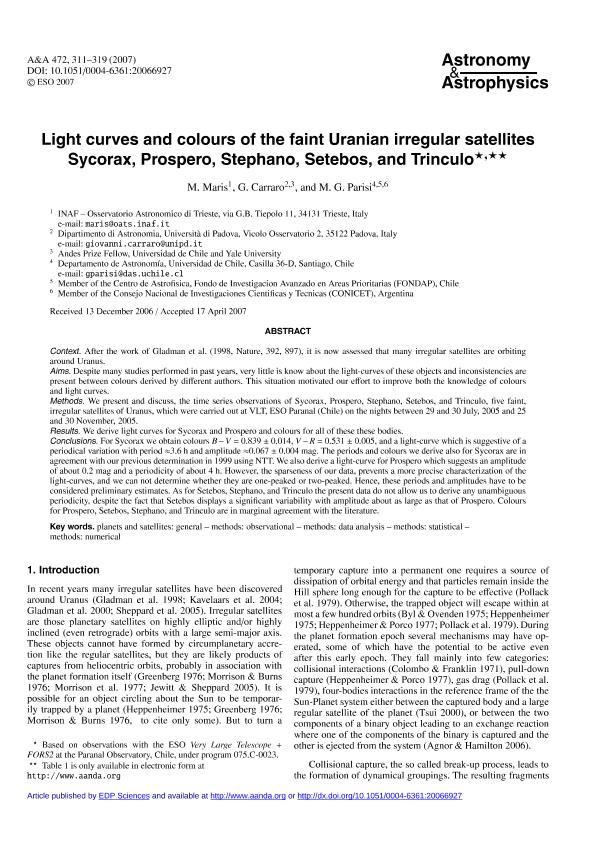Mostrar el registro sencillo del ítem
dc.contributor.author
Maris, M.
dc.contributor.author
Carraro, G.
dc.contributor.author
Parisi, Mirta Gabriela

dc.date.available
2017-06-08T13:22:33Z
dc.date.issued
2007-12
dc.identifier.citation
Maris, M.; Carraro, G.; Parisi, Mirta Gabriela; Light curves and colours of the faint Uranian irregular satellites Sycorax, Prospero, Stephano, Setebos, and Trinculo; Edp Sciences; Astronomy And Astrophysics; 472; 1; 12-2007; 311-319
dc.identifier.issn
0004-6361
dc.identifier.uri
http://hdl.handle.net/11336/17749
dc.description.abstract
Context: After the work of Gladman et al. (1998, Nature, 392, 897), it is now assessed that many irregular satellites are orbiting around Uranus. Aims: Despite many studies performed in past years, very little is know about the light-curves of these objects and inconsistencies are present between colours derived by different authors. This situation motivated our effort to improve both the knowledge of colours and light curves. Methods: We present and discuss, the time series observations of Sycorax, Prospero, Stephano, Setebos, and Trinculo, five faint, irregular satellites of Uranus, which were carried out at VLT, ESO Paranal (Chile) on the nights between 29 and 30 July, 2005 and 25 and 30 November, 2005. Results: We derive light curves for Sycorax and Prospero and colours for all of these these bodies. Conclusions: For Sycorax we obtain colours B-V = 0.839 ± 0.014, V-R = 0.531 ± 0.005, and a light-curve which is suggestive of a periodical variation with period ≈3.6 h and amplitude [aprox]0.067 ± 0.004 mag. The periods and colours we derive also for Sycorax are in agreement with our previous determination in 1999 using NTT. We also derive a light-curve for Prospero which suggests an amplitude of about 0.2 mag and a periodicity of about 4 h. However, the sparseness of our data, prevents a more precise characterization of the light-curves, and we can not determine whether they are one-peaked or two-peaked. Hence, these periods and amplitudes have to be considered preliminary estimates. As for Setebos, Stephano, and Trinculo the present data do not allow us to derive any unambiguous periodicity, despite the fact that Setebos displays a significant variability with amplitude about as large as that of Prospero. Colours for Prospero, Setebos, Stephano, and Trinculo are in marginal agreement with the literature.
dc.format
application/pdf
dc.language.iso
eng
dc.publisher
Edp Sciences

dc.rights
info:eu-repo/semantics/openAccess
dc.rights.uri
https://creativecommons.org/licenses/by-nc-sa/2.5/ar/
dc.subject
Planets
dc.subject
Satellites
dc.subject
Formation of Planets
dc.subject
Observational Methods
dc.subject
Data Analysis
dc.subject
Statistical Methods
dc.subject
Numerical Methods
dc.subject.classification
Astronomía

dc.subject.classification
Ciencias Físicas

dc.subject.classification
CIENCIAS NATURALES Y EXACTAS

dc.title
Light curves and colours of the faint Uranian irregular satellites Sycorax, Prospero, Stephano, Setebos, and Trinculo
dc.type
info:eu-repo/semantics/article
dc.type
info:ar-repo/semantics/artículo
dc.type
info:eu-repo/semantics/publishedVersion
dc.date.updated
2017-05-18T21:20:23Z
dc.journal.volume
472
dc.journal.number
1
dc.journal.pagination
311-319
dc.journal.pais
Francia

dc.description.fil
Fil: Maris, M.. Osservatorio Astronomico di Trieste; Italia
dc.description.fil
Fil: Carraro, G.. Universidad de Chile; Chile
dc.description.fil
Fil: Parisi, Mirta Gabriela. Universidad de Chile; Chile. Consejo Nacional de Investigaciones Científicas y Técnicas; Argentina
dc.journal.title
Astronomy And Astrophysics

dc.relation.alternativeid
info:eu-repo/semantics/altIdentifier/doi/http://dx.doi.org/10.1051/0004-6361:20066927
dc.relation.alternativeid
info:eu-repo/semantics/altIdentifier/url/http://adsabs.harvard.edu/abs/2007A%26A...472..311M
dc.relation.alternativeid
info:eu-repo/semantics/altIdentifier/url/https://www.aanda.org/articles/aa/abs/2007/34/aa6927-06/aa6927-06.html
Archivos asociados
